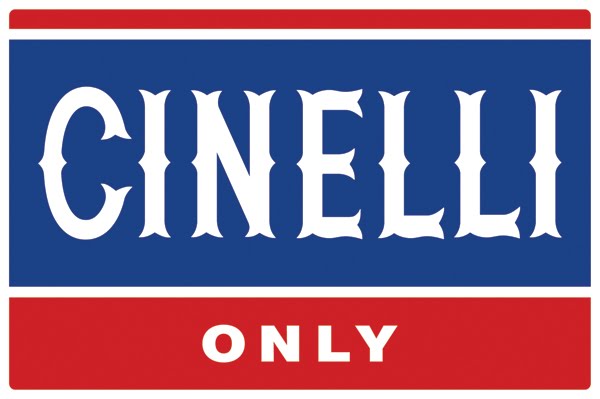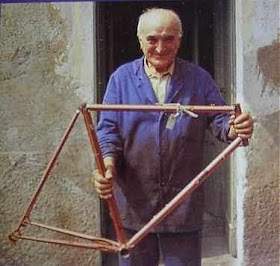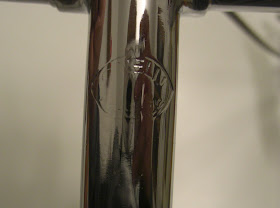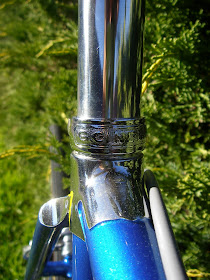
"A Visit with Cino Cinelli", a sketch of Cinelli's life and contributions to cycling based on his own account and supplemented by information obtained from his son Andrea. By David V. Herlihy (1986).
"Few bicycle racers rank as champions; even fewer parts manufacturers stand out as genuine innovators. Master frame designers can be counted on one hand. Seldom does one encounter a legendary figure with a legitimate claim to all three titles. Yet as I approached a modest villa in the picturesque Tuscan countryside, on one unforgettable fall afternoon in 1986, I would have an opportunity to do just that. The day's resplendent sunshine only added to the near-mystical aura surrounding my visit with Cino Cinelli.
Now seventy years of age, and still fit and vigorous, he lives quietly with his wife and young daughter. He acknowledges a certain lingering interest in the bicycle world, even admitting to an occasional jaunt himself. However, his main activity these days, he insists, is to tend to his olive trees. Ever since he retired, almost a decade ago, severing all ties with the company which still bears his name, bicycles are no longer an important part of his life. Or so he cautions the cycling devotees who occasionally drop by on some sort of pilgrimage.
Fortunately, after we settled in his cozy study and exchanged a few desultory remarks about olive trees, Cinelli's disclaimer proved increasingly suspect. It soon became apparent that the subject of bicycles still evokes a gleam in his eyes. When I questioned him about his vast experience with these graceful machines, spanning over a half century, he vividly recalled even the most minor details as if they had just occurred.
The seventh of ten children, Cino was born on a farm near Florence in 1916. His father, a small landowner of modest means, was on poor terms with both the ruling fascists and the opposition communists during Cino's rather turbulent childhood. This awkward predicament forced the family to uproot several times, though it remained on the outskirts of Florence.
Cino's introduction to the bicycle came at an early age, when he and his two older brothers, Giotto and and Arrigo, cycled several miles to their school in Florence. The boys' competitive nature transformed what should have been a routine commute into a veritable race--and sometimes even a fistfight. The two older boys, against their father's wishes, began to participate in local amateur races. Giotto was especially good, and he was an inspiration to young Cino, who still proudly recalls the day he stood on a glorious Tuscan hilltop to witness his brother's first victory. Naturally, Cino wanted to race too. But he would not have an easy time pursuing this dream. First, he had to contend with his father's vehement opposition. Second, the family's increasingly dire economic situation forced Cino to quit school at the age of 14 and to seek employment. Nor was his first boss, a doctor who used Cino as office help, inclined to accommodate an aspiring bicycle racer. Furthermore, it did not appear as if Cino, a rather frail youth, was blessed with a racer's physique or stamina.
Fortune would nonetheless match Cino's resolve. One day, as he was riding his over-sized sports bike down a country lane, he collided with a car, an unusual entity in those days. Picking himself up, along with his bicycle, a badly shaken Cino sprinted off, fearing the wrath of the driver. The gentleman nonetheless managed to catch up, and handed the startled youth a few crisp bills. He instructed Cino to fix his bike and to be more careful in the future. Not only was Cino able to repair his clunker, he also used his generous allowance to acquire the racing bike he had always coveted but could never afford.
Cino soon left the doctor's employ to take on a new job with a publisher. He was determined to educate himself, even if he could not attend school. His new boss encouraged not only the young man's avid reading habits, but also his racing aspirations, allowing the apprentice the time necessary to train. Cino still vividly recalls one of his first amateur races, in 1931, when he narrowly beat out a local lad for second place; a certain Gino Bartali. The winner, incidentally, was Bartali's cousin, who had already surpassed the age limit of fifteen by a good two years. But in those days, Cino grouses, unscrupulous racing authorities routinely turned a blind eye to such irregularities.
Over the next few years, Cino continued to shine in the local amateur circuit. Meanwhile, thanks to his rigorous work habits, he advanced rapidly through the ranks of the publishing house. But in 1937, at the age of 21, this delicate balancing act came to an abrupt end. The new management issued Cino an ultimatum: either give up racing or the job. Should he continue to compete, he would have to turn professional and renounce a steady job in a tenuous economy. Furthermore, it was by no means certain that he could make a living as a racer. Sponsors, at this time, were virtually non-existent. His earnings would have to come exclusively from prize winnings. Nevertheless, Cino gambled that he could survive by relying on Giotto's support and his own athletic ability. Fortune again responded favorably: the very day he quit his job he collected his first prize money.
In the 1938 Tour of Lombardy Cino faced, once again, his chief local rival, Gino Bartali, who was now likewise a professional, and a rising national star. The race evolved into an epic duel between the two, and, once again, Cino prevailed. The two Florentines, incidentally, are still close friends and occasionally get together. Cino confesses, however, that their encounters tend to be animated affairs, as the two old warriors rehash numerous debates that have lingered since their racing days. Evidently, an intense rivalry born long ago on bicycle saddles is carried forth today on living room chairs.
For the next six years, Cino raced professionally, serving stints with the Bianchi and Frejus teams. During that span, he compiled an impressive list of victories in such classics as the Giro di Lombardia, Giro di Piemonte, and Giro di Campania. But his greatest race, by his own estimation and by that of most observers, was his triumph in the grueling Milano-San Remo of 1943. "Late in my career," Cino reflects, "I realized that I got stronger the longer the race went on."
By this time, Italy was immersed in World War II, having entered on the side of Nazi Germany. But the fascist government vowed to sustain competitive cycling as a popular distraction. Cino, though nominally a soldier, was allowed to train and compete as a member of the state-sanctioned racing team. He would win one more contest in 1944, but he already knew that his racing days were behind him. Unlike Bartali and Coppi, Cino never raced again once the war ended the following year.
In 1946, at the age of 30, and still in his physical prime, he answered a new calling. Having experienced numerous technical failures during critical races, he had become increasingly interested in the mechanical side of cycling. Convinced that racing technology could be vastly improved, Cino set out to implement his ideas. He would exploit the technical knowledge he had gained from his racing career, and also his connections within the industry.
At first, he approached various manufacturers to offer suggestions, but he soon decided to produce and market racing bicycles and components himself. Cino moved to Milan so that he would be in the center of the Italian cycling industry. He then formed the first firm specialized in the distribution of cycle racing accessories. This enterprise began by serving federations and clubs, which at that time represented the entire Italian racing market.
From the onset, Cino manufactured stems, bars and frames. Initially, however, his own products accounted for only about a tenth of his total business. By the time Cino retired, that percentage had risen to about one half. But under his watch the firm never shed its principal identity as a distributor of high-end cycling components made by other manufacturers. Over the years, Cino marketed at home and abroad everything from Columbus tubes to Phil Wood hubs. His vast inventory included frame parts, tools, helmets, and cycle wear. The only prerequisite was that Cino had to personally validate the product.
Cino was always sensitive about his position as a middleman. He remarks, "I wanted to be able to deal with everyone in the bicycle business, from industrialists to artisans." He thus shied away from any exclusive arrangements that would limit his clientele or his influence. Consequently, nearly everyone in the trade openly sought Cino's valued advice. Even engineers treated him as a colleague.
But one of his most ardent listeners was a certain Gentullio Campagnolo. Cino recalls how he once convinced the vaunted parts maker from Vicenza to redesign his drop-outs, insisting that they had to be thicker. He also remembers advising Campagnolo to modify his seat post and hubs. Chuckling, Cino recounted how he once won a friendly bet between the two. "Campagnolo had just introduced a fork column, and I told him I could produce a better one at half his price." After examining his friend's submission, a dejected Campagnolo promptly withdrew his product and treated a triumphant Cino to a cup of coffee.
Cino and Tullio maintained a long and close friendship until the latter's death about four years ago. As far back as the1960 Olympic Games in Rome, the two jointly manned a booth to publicize their respective products, before the worldwide bike boom alleviated the need for such personal attention to business. But until that point, they shared some hard times. In particular, Cino recalls helping the struggling Campagnolo through some difficult financial straits. Once, a disgruntled Campagnolo creditor demanded that Cino pay him for his Campagnolo order, rather than Campagnolo himself, so as to extinguish a long-standing debt. Cino refused; he would pay no one other than Campagnolo for the parts that bore that name. No doubt, this special bond and mutual respect explains why the two manufacturers rarely presented competing products.
Notwithstanding Cino's primary role as a parts distributor, his own products gave the firm its illustrious name, and earned Cino a reputation as an implacable perfectionist. Here is a brief summary of his production over the years.
Stems and Bars
Bicycle stems and bars were always the mainstay of Cinelli's production, consistently accounting for at least 80% of his own sales. Even before the war, his brother Giotto had begun to manufacture steel stems and bars in Florence. In 1946, Cino took over that operation and brought it with him to Milan. The original staff included himself, his first wife Heidi (a Swiss national, and mother of Andrea), two office helpers and four assemblers.
Some firms, notably Ambrosio, today known primarily for its rims, were already using alloy in their stems and bars. Cinelli, however, always concerned with rigidity, originally stuck with steel. Only in 1963 did he introduced, half reluctantly, his first alloy stem and matching bar; and only because he was convinced that his combination was better than any on the market. (He continued to recommend steel bars for track riding, however). The A/I stem, as it was called, immediately became the industry standard. Graceful in design and strong in structure, it incorporated a number of novel features. A recessed allen-wrench fitting pointing toward the headset eliminated the need for a bulky protruding bolt. Nor was there any need to pry open the clamp when detaching the bars. Moreover, the stem's serrated inner surface kept the bars from getting scratched. In 1973, Cino designed the A/R stem, a sleeker model with a hidden bolt system. Scribbling furiously on my note pad, Cino explained in great detail how he adjusted the measurements of his stems and bars to ensure strength, elegance, and ease of use.
As racing bicycles gained popularity, primarily among high-end recreational riders, first in Europe during the early 1960s, and then in the United States by the end of that decade, Cinelli stems and bars were increasingly in demand. Annual production climbed from about 5,000 stems and bars in the 1950s, to 7,500 in the early 1960s. By Cino's retirement in 1978, the figure had reached a giddy 150,000. Yet despite the boom, Cinelli never relaxed his renowned quality standards. His staff grew slightly, and he modernized some techniques, but the products themselves remained the most refined and coveted in the cycle industry.
Racing frames
Frame production, however, could not be readily multiplied without a significant decline in quality. Although some Italian frame makers succumbed to the temptation to industrialize their production, Cino stubbornly resisted. First, he had no desire to claim a significant share of the market for racing frames. Such a position would pit him against his major clients in the parts business. In fact, Cino was determined not to jeopardize his role as an honest broker to the Italian cycle industry. The few frames he did produce were generally sold to the huge American market, where the competitive effect was miniscule. Nor did Cino ever outfit a professional team with his frames, so that other builders would not feel that he had deprived them of that honor. His track frames were, however, in high demand by Olympic federations that were free to chose whatever equipment they deemed best. In 1964, for example, the entire Japanese team used Cinelli frames, as did the 1968 Mexican team.
Cino's aversion to stepping up his frame production also reflected his determination to implement his own, sometimes unconventional, concepts, without regard to popular taste or industry trends. Furthermore, as a parts designer and dealer, he felt that it was extremely helpful to remain personally involved in the production of frames. As he saw it, the parts had to be designed around the frame. Consequently, a Cinelli, the so-called "Rolls-Royce of bicycles," remained a highly exclusive item, even as demand soared. The annual output hovered around two-hundred and fifty during the 1950s, and peaked at about six or seven hundred in the 1970s. Frames were only consigned per custom-order, and customers often had to wait months for delivery, or even longer when he had outstanding orders from Olympic athletes.
Of course, Cinelli frames were never cheap. But Cino maintains that their exorbitant price barely covered the meticulous production process. He insists that he never intended his frames to be moneymakers. Today he proudly affirms that "no Cinelli was ever assembled outside my factory." He notes that an American businessman once approached him with a plan to produce Cinellis in California on a larger scale, but Cino would have none of that.
Cinelli's frames were as limited in models as they were in numbers. Early on, he produced a relatively economical sports bike, and he also dabbled in track bikes and tandems. In 1974, he designed a novel aerodynamic "funny bike" which the Dane Ole Ritter rode to break his own hour record. One of Cino's last projects was the Laser, a futuristic aerodynamic frame. But, his enduring classic, the staple of his frame production, was the legendary Super Corsa road model. Produced with relatively few changes from 1947 on, its ride and durability are part of cycling lore. Cino muses how a Frenchman once advised him to redesign it. "Why?," asked a perplexed Cinelli. "They last too long," came the reply. "How can you expect any turnover?".
The fabled frame was the result of Cino's yen for a more rigid design. To this end, he conceived sloping fork crowns and the peculiar "fast-back" seat post-bolt system. Early on, the hired a Bianchi frame maker, Luigi Valsasina, to assist in frame production. (Now 85, Valsasina left the firm a few years after Cinelli's own exit). Cino recalls how his technician initially resisted such an unorthodox design. Cino, having an order to fill for the great Fausto Coppi, instructed Valsasina to build two bikes for the champion--one a traditional configuration and the other Cino's new design. Both frame-builder and racer were duly impressed with Cino's alternative, and the Super Corsa was born.
Cino maintains that the sloping fork crown adds rigidity by reducing the length of the fork blades. In his view, only the harshest courses, those comprised of cobblestone, demand a more flexible ride and hence the traditional flat fork crown. Arguably, the sloping design also makes the bicycle slightly more aerodynamic. Though the advantage is admittedly negligible, it is notable that aerodynamic considerations only came into vogue many years later. As for the "fast-back" design, that arrangement directly aligns the binder bolt with the center of top tube, assuring a firmer grip on the seat-post.
Despite the longevity of the Super Corsa, Cino did apply a few minor changes over the years. The very first frames used Reynolds tubing, until Columbus SL became the standard. The cast lugs at the ends of the top tube began to sport three drilled holes, escalating in size, after about 1960. Starting in the early 1970s, the fork crown and the bottom bracket shell were produced by "microfusion," a then unique bicycles Cinelli process of investment-casting that yielded parts of greater uniformity and strength. (Cinelli also marketed his frame components to other builders.) And like other Italian frames, later models allowed for shorter-reach brakes, and featured a lower bottom bracket and an increasing array of braze-ons.
The famous Cinelli head badge was originally a hand-painted metal plate screwed into the frame. Later, it became a decal instead. The basic design, which also adorned his steel stems and his bars, remained unchanged, however. It featured a knight's helmet, inspired by the one that Cino's dad kept around the house. To one side is a red giglio (lily), the symbol of Cino's native Florence, and on the other is a green serpent, the symbol of his adoptive Milan.
Seats and other products
Before 1960, racers used leather saddles almost exclusively. In fact, some artisans made a living by reshaping worn leather saddles for cyclists. Cino himself remembers entering one race perched atop a brand new Brooks saddle. But at a certain point the skies opened up and his once shiny and firm saddle became a sopping and saggy disappointment. Cino became convinced that there had to be a better material for racing saddles.
Years later, as a manufacturer, he approached one of his brothers who had gone into the plastics business to see if that material could provide comfortable yet rigid support. His brother responded favorably, but cautioned Cino that he would have to order saddles by the thousands to price them competitively. An enthused Cino tried unsuccessfully to enlist Campagnolo in his bold venture. Finally, he discovered that Tommaso Nieddu of Turin, founder of the Vittoria derailleur, had begun to manufacture saddles made of Rilsan, a synthetic material invented in France. Cino formed a partnership with Nieddu (known as Unicantor), and redesigned the seat to include a buffalo hide covering, for extra comfort and traction. Before long, this innovative product captured the racing market and put saddle re-shapers out of business.
Other notable Cinelli products include the resilient Binda toestraps, and the sleek M-71 clip-on track pedal, introduced in 1973. Although the latter product was short-lived, the French ski manufacturer Look eventually developed and applied the concept with great technical and commercial success. One of Cino's most imaginative ideas was a system that accommodated interchangeable front and rear wheels, designed primarily to facilitate wheel changes during races. The special freewheel, manufactured by Regina, attached independently to the frame. The hubs, manufactured by Campagnolo, could be fitted either into the freewheel or the front fork. Cino sold a number of bicycles with this system to Americans in the late 1960s, but the idea never caught on. Still, it remains one of Cino's most cherished concepts.
Cino's future plans call for a peaceful life in the countryside with his family, growing and harvesting olives. He is reluctant to leave the land he loves, even temporarily. He has no great desire to travel, and has never crossed the Atlantic, despite numerous invitations from American friends like the Chicago-based Schwinn family. Still, he is by no means detached from the rest of the world. His library contains numerous articles that have been written about him over the years in such far-flung countries as France, England, Japan, and the United States (he seems particularly proud of the article that appeared in Playboy in the early 1970s). And he maintains a rapport with numerous cyclists worldwide that he equipped over the years, effortlessly ticking off names and measurements. He relishes a collection of art objects sent by clients, sometimes in lieu of cash payment, as was the case with some residents of developing countries.
And, truth be told, his technical advice is still solicited by many in the Italian cycle industry. Among those who consult regularly with Cino is his own son Andrea, who is about to start his own bicycle company. Called Cinettica, it will market radically new frames and accessories.
As I reluctantly prepared to leave, I prodded Cino to weigh in on the state of cycling. He cites a need for improved road networks to accommodate cyclists, but he also advocates fundamental changes in design. After we paused for a Sunday afternoon dessert, Cino led me down to his basement where he elaborated on his technical ideas. There, resting against a well-scribbled blackboard, was his own bike--a Cinelli, of course. This classic rust-colored gem sported two 26" wheels and extra-long cranks. According to Cino, this is the ideal set-up for a road bike. "27" wheels were designed fifty years ago when we had much poorer roads," he groused, "It just doesn't make sense that we still ride these wheels today." Cino adamantly maintains that cyclists benefit from the higher cadence that goes along with smaller wheels, and that longer cranks provide better leverage.
Yet for all his innovative spirit, Cino is surprisingly conservative about certain things. He doesn't like the new Cinelli logo (a multi-colored "C"), for example. "I guess they felt they had to change something," he allows, "the way a new boss rearranges furniture" (The new owner, incidentally, is the Colombo family, owners of Columbus tubing). At the mention of Campagnolo's recently revamped line of "aerodynamic" components, Cino makes a face and utters a single word: brutto (ugly).
With regard to new frame designs and materials, Cino remains skeptical. He dismisses the "squished" steel frames, popular a few years back during the aerodynamic craze. "There is nothing stronger than a round tube," he asserts. He does hold out some hope for composite frames, provided certain technical objections are overcome. He mentions that he is about to receive such a frame shortly for his evaluation.
Night had fallen, and it was time for me to go. As he bade me a hearty good-bye, Cino promised to prepare a jug of olive oil for my next visit. "You know, when I first moved here," he noted with a tone of self-satisfaction, "the local growers all smirked. What could a man who just yesterday was a bicycle mechanic know about olive oil? Well, I cultivated my olive trees the same way I did my bicycles." Is it any wonder why his humbled neighbors now clamor for Cino's advice?"
Photo: 1935, Colli Fiorentini race photo showing the winner Giotto Cinelli on the right (holding flowers) and his younger brother Cino on the left. (Photo courtesy of Steven Maasland)
Contributions to CINELLI ONLY are welcome; contact veronaman@gmail.com










































